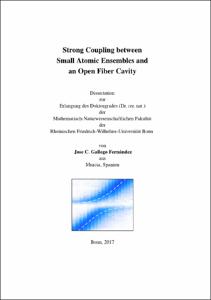Strong Coupling between Small Atomic Ensembles and an Open Fiber Cavity

Strong Coupling between Small Atomic Ensembles and an Open Fiber Cavity

| dc.contributor.advisor | Meschede, Dieter | |
| dc.contributor.author | Gallego Fernández, Jose C. | |
| dc.date.accessioned | 2020-04-25T00:59:46Z | |
| dc.date.available | 2020-04-25T00:59:46Z | |
| dc.date.issued | 12.04.2018 | |
| dc.identifier.uri | https://hdl.handle.net/20.500.11811/7530 | |
| dc.description.abstract | In this work I present the experimental realization of a versatile platform for the interplay between light and matter at the single-quanta level. In particular, I demonstrate the high cooperativity of small ensembles of rubidium atoms strongly coupled to a state-of-the-art, open fiber-based microcavity, emphasizing the capabilities of the system as an efficient source and storage device for single photons. The first part of this thesis focusses on the construction and characterization of the microresonator, which is composed of two dielectric mirrors machined on the end-facets of optical glass fibers. Through the implementation of an in-house facility, a large number of fiber-based mirrors are manufactured and precisely characterized. I present a theoretical model that explains, for the first time, the asymmetry in their reflective line shape and that has important implications for the optimal alignment of fiber-based cavities. In the following chapter, I introduce the main experimental apparatus, which contains a miniaturized fiber cavity -- with small mode volume and a linewidth of k≈2(pi)x25 MHz -- that is actively stabilized and integrated in a compact assembly. The monolithic structure features several high-numerical aperture (NA) lenses that provide the necessary tools for the trapping, manipulation and high-resolution imaging of atoms inside the resonator. Neutral rubidium atoms are delivered by an optical conveyor belt from the cooling region into the cavity mode, where their presence is monitored by probing the cavity field. This allows us to perform real-time optical feedback in the transport scheme and to observe the characteristic vacuum Rabi splitting for individual atoms in a non-destructive manner. Due to the small mode volume of the microcavity, coupling strengths up to g=2(pi)x100 MHz are observed for single atoms, corresponding to light-matter interaction in the strong coupling regime. The system's cooperativity is collectively enhanced more than five times when placing a small atomic ensemble inside the resonator. Such a fast interaction rate and the high transmission of the input cavity mirror provide a rapid, non-destructive readout of the internal hyperfine state of a coupled atom, yielding fidelities of 99.8% in 5 ms with less than 1% population transfer and negligible atom losses. The last part of the thesis is dedicated to the study of the influence of the cavity on the emission properties of an atom. I show how, despite the small solid angle covered by the cavity mode, the resonator alters the radiation pattern of an externally pumped single atom and increases its emission rate by a factor of 15 due to the process known as cavity back-action. More than 90% of the emitted photons are collected by the single cavity-mode -- as a result of the strong Purcell enhancement -- and subsequently channeled out by one of the fiber mirrors. A characterization of the photon statistics of the cavity output shows a clear antibunching dip, confirming that the emission corresponds to a single quantum emitter and that our system can be used as a readily fiber-coupled, efficient single-photon source. | en |
| dc.language.iso | eng | |
| dc.rights | In Copyright | |
| dc.rights.uri | http://rightsstatements.org/vocab/InC/1.0/ | |
| dc.subject.ddc | 530 Physik | |
| dc.title | Strong Coupling between Small Atomic Ensembles and an Open Fiber Cavity | |
| dc.type | Dissertation oder Habilitation | |
| dc.publisher.name | Universitäts- und Landesbibliothek Bonn | |
| dc.publisher.location | Bonn | |
| dc.rights.accessRights | openAccess | |
| dc.identifier.urn | https://nbn-resolving.org/urn:nbn:de:hbz:5n-50215 | |
| ulbbn.pubtype | Erstveröffentlichung | |
| ulbbnediss.affiliation.name | Rheinische Friedrich-Wilhelms-Universität Bonn | |
| ulbbnediss.affiliation.location | Bonn | |
| ulbbnediss.thesis.level | Dissertation | |
| ulbbnediss.dissID | 5021 | |
| ulbbnediss.date.accepted | 07.12.2017 | |
| ulbbnediss.institute | Mathematisch-Naturwissenschaftliche Fakultät : Fachgruppe Physik/Astronomie / Institut für angewandte Physik (IAP) | |
| ulbbnediss.fakultaet | Mathematisch-Naturwissenschaftliche Fakultät | |
| dc.contributor.coReferee | Koehl, Michael |
Files in this item
This item appears in the following Collection(s)
-
E-Dissertationen (4379)




